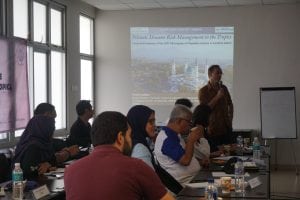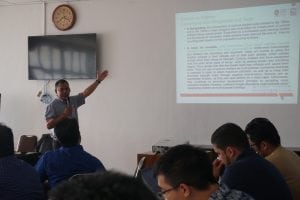By
Jose Limbay Lahi O. Espaldon (University of the Philippines Los Banos, Philippines)
Divina Gracia Baclig (CARE Philippines)
Kapil Ghosh (University of Calcutta, India)
Universitas Gahdja Mada, Yogyakarta Indonesia — In a world full of uncertainties and inevitable conditions, there are different ways on which we can contribute to positive development and growth. As the old adage goes, the only constant thing in the world is change. The Earth is continually being shaped by natural processes. Natural forces, such as geologic and geomorphological processes, transform the topography of the Earth, thereby affecting the way of life of people. Due to these changes, society is also being transformed. The lectures by Dr. Rohayu Che Omar, Dr. Franck Lavigne, and Dr. Mohd Hairy Ibrahim emphasize this.
Assessment. Evaluation. Processes. Seeing the possibilities of mass movement of soil, rocks and debris, also known as landslides, is very important. All regions have different approaches in this area, but we all have something in common, how do we alleviate the risks and hazards of these disasters? We have different ways on how to do this. From policies, also known as non-structural, and some are structural (engineering marvels) according to Dr. Rohayu Che Omar. Creating a different process in assessing landslides is one way of contributing to the pool of knowledge to solve the problem of the risks for these disastrous events. With developing programs hand-in-hand with private corporations and scientists, they developed a program, an early warning system, that may help the communities to be less vulnerable to these risks. The development of this program will be one of the few technologies to be developed that may help continue the casualties and mortalities for certain areas with these problems.

Looking back to see the future. Studying current situations through historical data may be underutilized by some disciplines. The combination of historical events, current situations is important and was well used by Dr. Franck Lavigne. Studying volcanic activity and its effects of the Samalas volcano in Lombok Island. Integration of historical data, stories and legends found in “Babad”. The method of using archaeological data, geological data, and social sciences, the data produced found interesting results. These ranged from the “normal” topographical sites to man-made valleys from quarrying, to the creation of agricultural land after years of mining. In using similar methods, identification, description and addressing volcanic risks may be easier, and with gathering enough information, it will address challenges in a more integrated approach.

Everything changes. If one has not noticed the change in rainfall, intensity of storms and typhoons, intense weather conditions, then you have been living under a rock. Climate change is one of the hottest topics that are scrutinized and focused on. Creation of a formal platform in the education of the people, should be one of the priorities in policies and education according to Dr. Mohd Hairy Ibrahim. The inclusion of Climate Change Education and Education for Sustainable Development is important and was recognized at UNESCO in the year 2009. He mentioned the three main domain of approaches in climate change. He pointed out the importance of disaster governess and sustainable leadership to deal the issues of climate change. Role of higher education institutions in climate change and sustainable development was also mentioned in his lecture. He also mentioned how education is affected by climate change as well as the difficulties of incorporating the subject matter of climate change in school education. He told that the climate change is becoming more challenging to response in arena on rapidly changing world. He addressed the issues of Climate Change Education (CCE) in global context. He has given examples of eco-school from Australia, Japan and role of CCE in community resilience in different parts of the world. He has presented a guide line for schools on climate action. He concluded that the climate change should be subject matter of all subject and all school should be climate resilience school. This final lecture of the day has opened a new window of climate change and disaster management.

With different knowledge, how do we use these for continuing development of the human civilization? Interdisciplinary studies and integration of all these knowledges can and is the key for sustainable growth and development. One view may not be as prominent as others, but looking into the bigger picture, however small, contributes to all.
